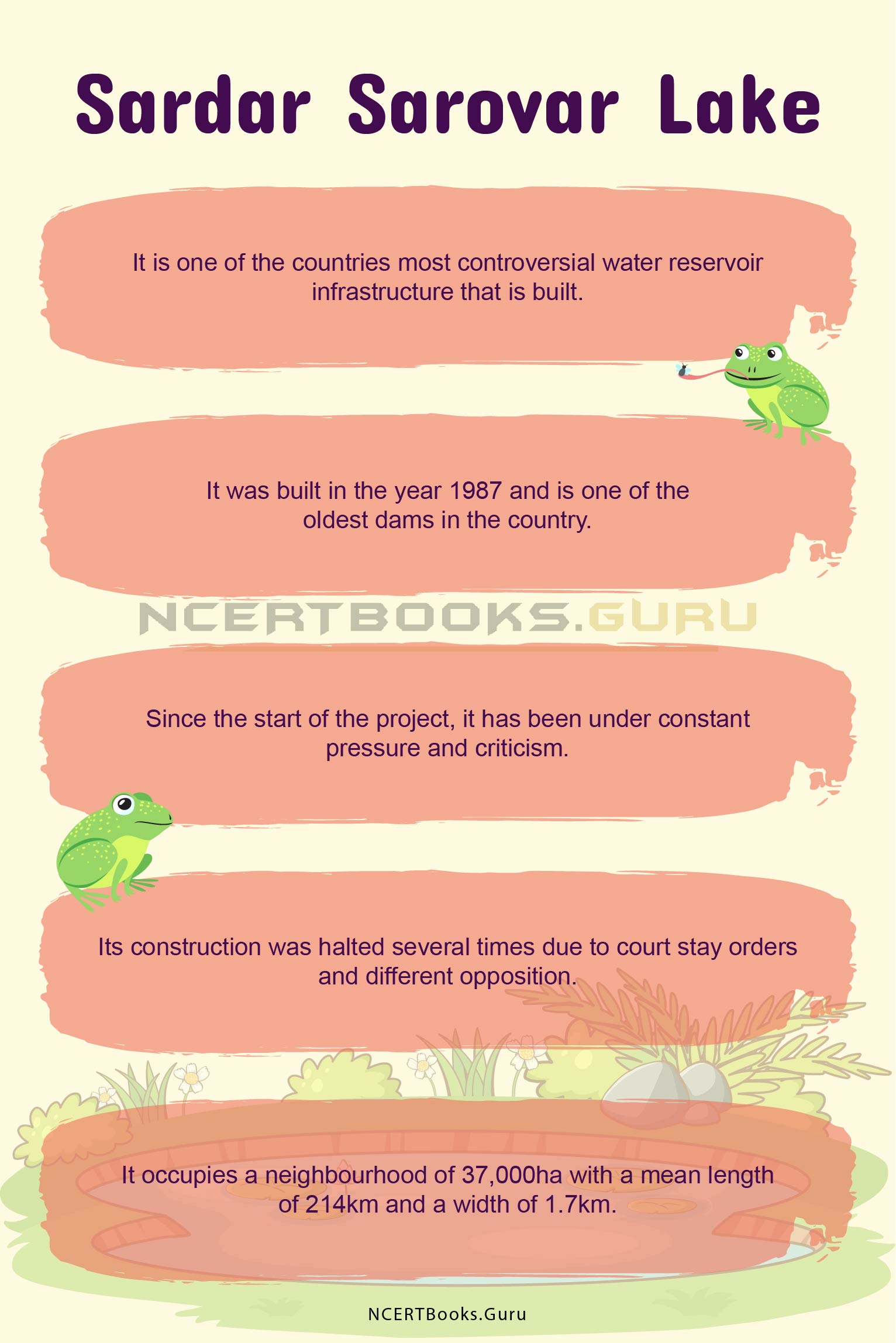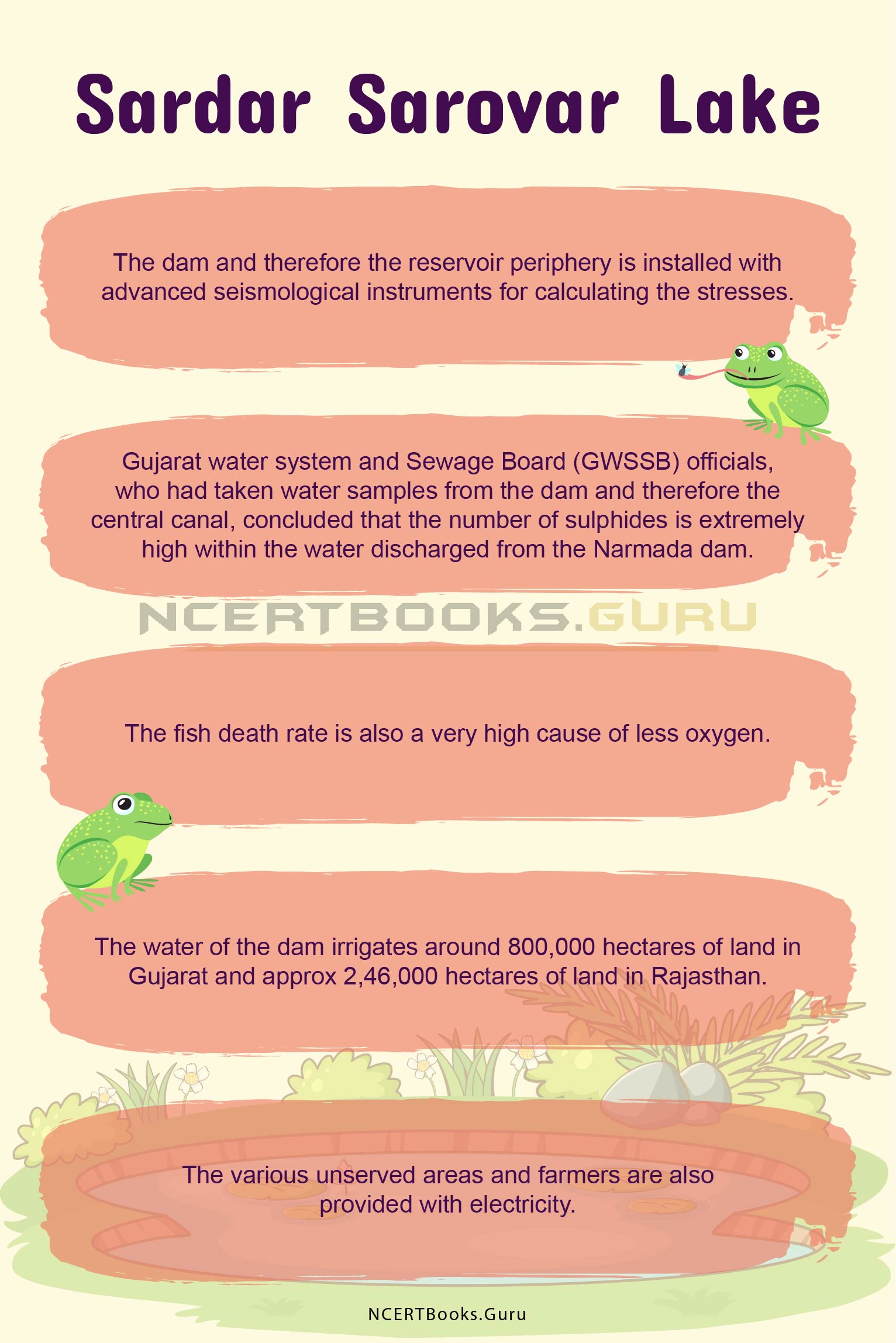Sardar Sarover lake is a dam that is located on the Indian Narmada river in the state of Gujarat. It is one of the countries most controversial water reservoir infrastructure that is built. It was built in the year 1987 and is one of the oldest dams in the country.
Sardar Sarovar Lake details
| Name of the lake | Sardar Sarovar lake |
| Primary source | Being a dam it doesn’t have one |
| Location | Gujarat |
| Length | 1210 meters |
| breadth | 1.7kms |
| importance | Provides hydro- power to the people, helps in agriculture and socio economic development |
| Pollution | rampant plantation of willows,Encroachments, and siltation |
About Sardar Sarovar lake
The Sardar Sarovar Lake is a 1,210m long concrete gravity dam with a proposed final height of 163m above the deep foundation that it is laid upon. Its present size is 121.9m. During its construction, about 7 million cubic meters of chilled cement was required. The Sardar Sarovar dam has 0.95 Mhm of storage capacity, which can contain a lot of water and 0.586M.Ha.m of live storage capacity.
It occupies a neighbourhood of 37,000ha with a mean length of 214km and a width of 1.7km. The river catchment basin above the dam site is 88,000 square kilometres. it’s a spillway discharging capacity of 87,000 cubic metres a second.
The dam and therefore the reservoir periphery is installed with advanced seismological instruments for calculating the stresses. The whole reservoir level of the SSD is 138.6m, the utmost water level is 140.2m, and the minimum drawdown level is 110.6m. The tailwater level is about 25.9m.
It also supplied water to the people of Gujarat, the various wildlife sanctuaries and the different industries.
Have a look at the List of Important Lakes in India that you need to know for your competitive exams to score well.
Sardar Sarovar lake History
In the year 1946, the plans were initiated for the Sardar Sarovar basin. Since the start of the project it has been under constant pressure and criticism. Its construction was halted several times due to court stay orders and different opposition. Works couldn’t start thanks to water sharing disputes among the concerned Maharashtra, Rajasthan, Gujarat and Madhya Pradesh states. To resolve the problems and allocate the water shares, Narmada Water Dispute Tribunal was formed in October of 1969. Construction of the dam began in April 1987 once the NWDT reached an agreement in 1979. Funds backed the development from the planet Bank.
The Narmada Bachao Andolan was a group of local people that opposed the project in 1989. The planet Bank withdrew the funding in 1993 following massive protests, leading to delays to the project.
In May 1995 the construction was stopped as per the Supreme Court’s stay. It resumed in February 1999, and therefore the dam’s height was increased from the planned 80m to 88m. The Court allowed the rise of the dam’s size to 90m in October 2000 but ordered adherence to the rehabilitation and resettlement issues. The dam’s height was increased to hundred and ten metres with accordance to Narmada Control Authority new conditions, in June 2004. it had been further raised to its current 121.9m height in December 2006.
Sardar Sarover lake map
The SSD may be a 1,210m long concrete gravity dam with a proposed final height of 163m above the deep foundation. Its present size is 121.9m. Chilled concrete of about seven million cubic metres was required to be poured in.
It occupies a neighbourhood of 37,000ha with a mean length of 214km and a width of 1.7km. The river catchment basin above the dam site is 88,000 square kilometres. it’s a spillway discharging capacity of 87,000 cubic metres a second.
The dam and therefore the reservoir periphery is installed with advanced seismological instruments for calculating the stresses. 23 service spillway gates and seven chute spillway radial gates are installed for control. The whole reservoir level of the SSD is 138.6m, the utmost water level is 140.2m, and the minimum drawdown level is 110.6m. The tailwater level is about 25.9m.
Sardar Sarover lake system
The Sardar Sarovar Dam has two hydropower generating units. There is a powerhouse (RBPH) station that has six because of the 1,200MW underground river bed, it also contains 200MW units of reversible Francis type turbines, supplied by BHEL and Sumitomo.
The 250MW surface canal head powerhouse (CHPH) consists of 5,50MW Kaplan turbines. By December 2004 and RBPH by November 2006 the CHPH power units were commissioned and the facility stations are connected to a Gas Insulated Switchgear and bus bars switchyard complex in RBPH. Electricity is distributed to Madhya Pradesh at 57%, Gujarat at 16% and Maharashtra at 27% through a 400kV power cable.
Sardar Sarovar lake Pollution
Gujarat water system and Sewage Board (GWSSB) officials, who had taken water samples from the dam and therefore the central canal, concluded that the number of sulphides is exceptionally high within the water discharged from the Narmada dam. GWSSB had stopped beverage supply from the channel in Narmada, Chhota Udepur and parts of Vadodara.
GWSSB had stopped beverage supply from the canal in Narmada, Chhota Udepur and parts of Vadodara. There is no water within the downstream which is filled only with sewage and industrial wastewater. The economic effluents are discharged from Ankleshwar, Jhagadia, Panoli, and Dahej industrial clusters which are notorious for his or her non-compliance of prescribed standards for effluent discharges. The river is now susceptible to flash floods with a dry river bed stretch.
This is often severely impacting the ecology, biodiversity, fishery, livelihoods of the fisherfolks, downstream villagers, tribals, natural and cultural resources, wildlife sanctuary and lakhs of people living on the brink of and hooked into the river directly or indirectly.
Sardar Sarovar Lake Importance
Sardar Sarovar Dam is 1.2 kilometres long, and therefore the height of the dam was increased to 138.68 metres in 2017. it’s the third-highest concrete dam in India. The water of the dam irrigates around 800,000 hectares of land in Gujarat and approx 2,46,000 hectares of land in Rajasthan.
It’s said that it provides water to 131 towns and cities and around 9,633 villages within the four states. The level of water within the submergence area of the dam in Dhar and Bharawani districts of Madhya Pradesh is rising steadily. Consistent with the Narmada Bachao Andolan group, around 40,000 families in 192 villages in Madhya Pradesh would be dispatched when the reservoir is filled to its optimum capacity. Many dry towns, villages and districts of Gujarat are served the water from the reservoir which has been seen as quite beneficial over the years.
The various unserved areas and farmers are also provided with electricity. Not just does the dam serve farmers with electricity but it provides basic amenities like drinking water and water for irrigation. It provides flood protection to a neighbourhood of about 30,000 hectares. Wildlife sanctuaries also will be benefited.

Short Essay on Sardar Sarovar Lake
Sardar Sarover lake is a dam that is located on the Indian Narmada river in the state of Gujarat. In the year 1946, the plans were initiated for the Sardar Sarovar basin. Its construction was halted several times due to court stay orders and different opposition. Works couldn’t start thanks to water sharing disputes among the concerned Maharashtra, Rajasthan, Gujarat and Madhya Pradesh states. Construction of the dam began in April 1987 once the NWDT reached an agreement in 1979. Funds backed the development from the planet Bank. The Narmada Bachao Andolan was a group of local people that opposed the project in 1989. The planet Bank withdrew the funding in 1993 following massive protests, leading to delays to the project.
It occupies a neighbourhood of 37,000ha with a mean length of 214km and a width of 1.7km. The river catchment basin above the dam site is 88,000 square kilometres. it’s a spillway discharging capacity of 87,000 cubic metres a second.
The dam and therefore the reservoir periphery is installed with advanced seismological instruments for calculating the stresses. 23 service spillway gates and seven chute spillway radial gates are installed for control.
The various unserved areas and farmers are also provided with electricity. Not just does the dam serve farmers with electricity but it provides basic amenities like drinking water and water for irrigation provides flood protection to a neighbourhood of about 30,000 hectares. Wildlife sanctuaries also will be benefited.
GWSSB had stopped beverage supply from the canal in Narmada, Chhota Udepur and parts of Vadodara. There is no water within the downstream which is filled only with sewage and industrial wastewater. The economic effluents are discharged from Ankleshwar, Jhagadia, Panoli, and Dahej industrial clusters which are notorious for his or her non-compliance of prescribed standards for effluent discharges. The river is now susceptible to flash floods with a dry river bed stretch.
This is often severely impacting the ecology, biodiversity, fishery, livelihoods of the fisherfolks, downstream villagers, tribals, natural and cultural resources, wildlife sanctuary and lakhs of people living on the brink of and hooked into the river directly or indirectly.
10 Lines on Sardar Sarover lake
- It is one of the countries most controversial water reservoir infrastructure that is built.
- It was built in the year 1987 and is one of the oldest dams in the country.
- Since the start of the project, it has been under constant pressure and criticism.
- Its construction was halted several times due to court stay orders and different opposition.
- It occupies a neighbourhood of 37,000ha with a mean length of 214km and a width of 1.7km.
- The dam and therefore the reservoir periphery is installed with advanced seismological instruments for calculating the stresses.
- Gujarat water system and Sewage Board (GWSSB) officials, who had taken water samples from the dam and therefore the central canal, concluded that the number of sulphides is extremely high within the water discharged from the Narmada dam.
- The fish death rate is also a very high cause of less oxygen.
- The water of the dam irrigates around 800,000 hectares of land in Gujarat and approx 2,46,000 hectares of land in Rajasthan.
- The various unserved areas and farmers are also provided with electricity.

FAQs on Sardar Sarovar Lake
Question 1.
Where is Sardar Sarover located?
Answer:
Sardar Sarover lake is a dam that is located on the Indian Narmada river in the state of Gujarat.
Question 2.
How much power does the Sardar Sarover dam make?
Answer:
The 250MW surface canal head powerhouse (CHPH) consists of 5, 50MW Kaplan turbines. By December 2004 and RBPH by November 2006 the CHPH power units were commissioned and the facility stations are connected to a Gas Insulated Switch Gear and bus bars switchyard complex in RBPH. Electricity is distributed to Madhya Pradesh at 57%, Gujarat at 16% and Maharashtra at 27% through a 400kV power cable.
Question 3.
What type of fishes are found in Sardar Sarovar?
Answer:
The fishes that are found in the dam are commercial fishes. And these fishes are finding it difficult to live in that habitat because of the deficient oxygen.
Question 4.
How much land is irrigated with the water from the Sardar Sarovar Dam?
Answer:
Around 800,000 hectares of land in Gujarat and approx 2,46,000 hectares of land in Rajasthan are irrigated by the water of the dam.
